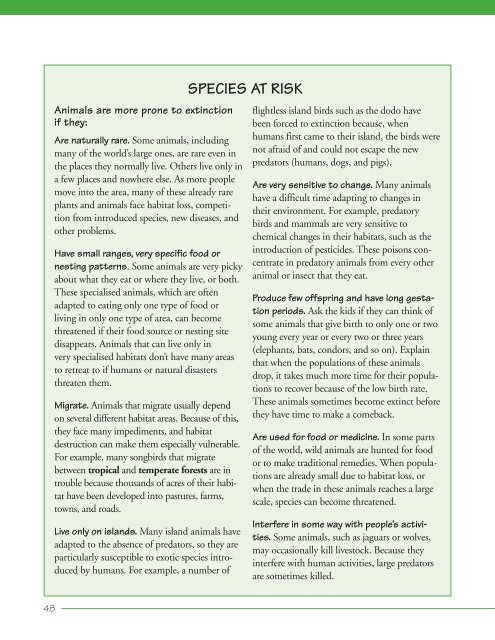EXPLORING BIODIVERSITY: A Guide for Educators Around the World
EXPLORING BIODIVERSITY: A Guide for Educators Around the World
EXPLORING BIODIVERSITY: A Guide for Educators Around the World
You also want an ePaper? Increase the reach of your titles
YUMPU automatically turns print PDFs into web optimized ePapers that Google loves.
Animals are more prone to extinction<br />
if <strong>the</strong>y:<br />
Are naturally rare. Some animals, including<br />
many of <strong>the</strong> world’s large ones, are rare even in<br />
<strong>the</strong> places <strong>the</strong>y normally live. O<strong>the</strong>rs live only in<br />
a few places and nowhere else. As more people<br />
move into <strong>the</strong> area, many of <strong>the</strong>se already rare<br />
plants and animals face habitat loss, competition<br />
from introduced species, new diseases, and<br />
o<strong>the</strong>r problems.<br />
Have small ranges, very specific food or<br />
nesting patterns. Some animals are very picky<br />
about what <strong>the</strong>y eat or where <strong>the</strong>y live, or both.<br />
These specialised animals, which are often<br />
adapted to eating only one type of food or<br />
living in only one type of area, can become<br />
threatened if <strong>the</strong>ir food source or nesting site<br />
disappears. Animals that can live only in<br />
very specialised habitats don’t have many areas<br />
to retreat to if humans or natural disasters<br />
threaten <strong>the</strong>m.<br />
Migrate. Animals that migrate usually depend<br />
on several different habitat areas. Because of this,<br />
<strong>the</strong>y face many impediments, and habitat<br />
destruction can make <strong>the</strong>m especially vulnerable.<br />
For example, many songbirds that migrate<br />
between tropical and temperate <strong>for</strong>ests are in<br />
trouble because thousands of acres of <strong>the</strong>ir habitat<br />
have been developed into pastures, farms,<br />
towns, and roads.<br />
Live only on islands. Many island animals have<br />
adapted to <strong>the</strong> absence of predators, so <strong>the</strong>y are<br />
particularly susceptible to exotic species introduced<br />
by humans. For example, a number of<br />
SPECIES AT RISK<br />
flightless island birds such as <strong>the</strong> dodo have<br />
been <strong>for</strong>ced to extinction because, when<br />
humans first came to <strong>the</strong>ir island, <strong>the</strong> birds were<br />
not afraid of and could not escape <strong>the</strong> new<br />
predators (humans, dogs, and pigs).<br />
Are very sensitive to change. Many animals<br />
have a difficult time adapting to changes in<br />
<strong>the</strong>ir environment. For example, predatory<br />
birds and mammals are very sensitive to<br />
chemical changes in <strong>the</strong>ir habitats, such as <strong>the</strong><br />
introduction of pesticides. These poisons concentrate<br />
in predatory animals from every o<strong>the</strong>r<br />
animal or insect that <strong>the</strong>y eat.<br />
Produce few offspring and have long gestation<br />
periods. Ask <strong>the</strong> kids if <strong>the</strong>y can think of<br />
some animals that give birth to only one or two<br />
young every year or every two or three years<br />
(elephants, bats, condors, and so on). Explain<br />
that when <strong>the</strong> populations of <strong>the</strong>se animals<br />
drop, it takes much more time <strong>for</strong> <strong>the</strong>ir populations<br />
to recover because of <strong>the</strong> low birth rate.<br />
These animals sometimes become extinct be<strong>for</strong>e<br />
<strong>the</strong>y have time to make a comeback.<br />
Are used <strong>for</strong> food or medicine. In some parts<br />
of <strong>the</strong> world, wild animals are hunted <strong>for</strong> food<br />
or to make traditional remedies. When populations<br />
are already small due to habitat loss, or<br />
when <strong>the</strong> trade in <strong>the</strong>se animals reaches a large<br />
scale, species can become threatened.<br />
Interfere in some way with people’s activities.<br />
Some animals, such as jaguars or wolves,<br />
may occasionally kill livestock. Because <strong>the</strong>y<br />
interfere with human activities, large predators<br />
are sometimes killed.<br />
48

















